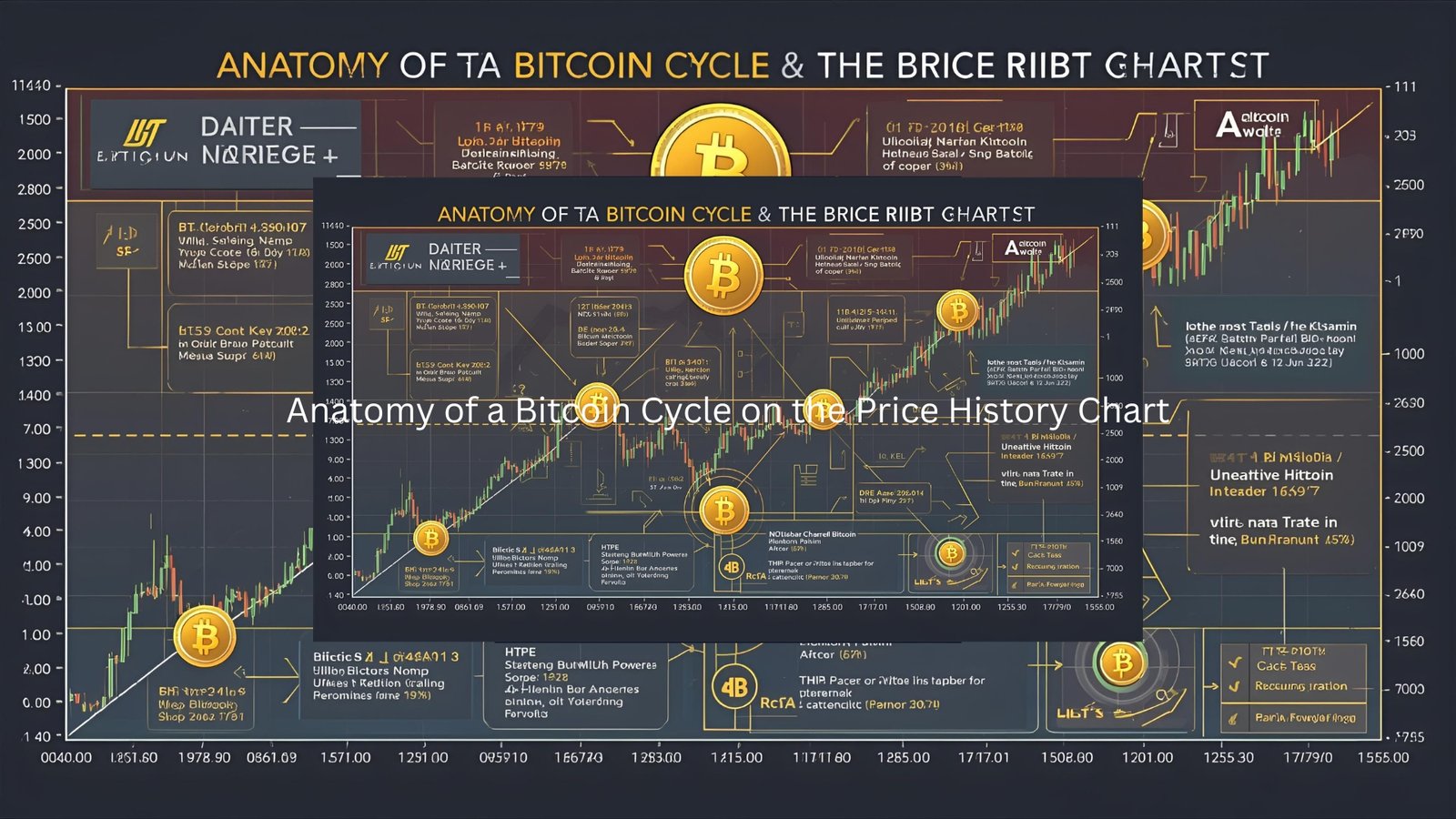The phrase Bitcoin Price History Chart is more than a search term; it is a time machine that compresses over a decade of innovation, speculation, panic, and resilience into a single, evolving visual. For newcomers, the chart looks like a string of mountains and valleys. For seasoned traders, it’s a familiar map of crypto market cycles, halving events, and liquidity tides.
When you learn how to read the Bitcoin Price History Chart, you gain a perspective that filters out noise, anchors expectation, and turns data into decisions. This guide walks you through how to interpret long-term and short-term moves, what historically drove explosive rallies and painful pullbacks, and how to apply these lessons to your own strategy without falling into the trap of overfitting the past.
Because Bitcoin trades 24/7 and responds to global forces—monetary policy shifts, institutional adoption, technological upgrades, and regulatory headlines—the Bitcoin Price History Chart behaves differently than traditional assets. You’ll see volatility unlike blue-chip stocks, but you’ll also discover repeating structures: accumulation, markup, distribution, and markdown. You’ll learn how support and resistance, moving averages, logarithmic scaling, and on-chain metrics help decode those structures. And you’ll see why no single indicator can tell the whole story without context.
By the end of this article, you’ll be able to read the Bitcoin Price History Chart with confidence, recognize the psychology behind its patterns, and understand practical ways to use the chart for risk management, long-term conviction, or short-term timing.
Table of Contents
ToggleWhat the Bitcoin Price History Chart Really Shows
The Bitcoin Price History Chart is a living record of supply and demand expressed through price over time. Each candle is a snapshot of market sentiment. Stitched together, those snapshots form cycles: sideways consolidation, breakout, trend, and reversal. Price alone, though, is only part of the picture. Experienced analysts overlay other layers—volume profiles, moving averages, on-chain activity, and macro cues—to interpret what price is signaling.
Why Bitcoin’s Chart Behaves Differently
Bitcoin is both a technology and an asset. As a decentralized network, it changes in predictable ways—particularly through its halving schedule, which reduces the issuance of new BTC approximately every four years. This programmed scarcity has historically constrained supply, and many analysts link post-halving periods with strong uptrends. Meanwhile, the asset trades globally, reacts to liquidity conditions, and attracts speculative capital. The result is a chart that often trends hard and corrects hard. The Bitcoin Price History Chart reflects this dual nature: high beta to liquidity with periodic structural catalysts from protocol design.
Why Long-Term Charts Matter
Open any short-term timeframe and you’ll see noise. Step back to the weekly or monthly view, preferably on a log scale, and the Bitcoin Price History Chart becomes a stairway—surges followed by consolidations that set higher floors over time. The log scale compresses vertical extremes so you can observe the rate of change and trend slopes more clearly. Long-term charts help prevent emotional decisions based on intraday volatility and keep the big picture in focus.
How to Read the Bitcoin Price History Chart Like an Analyst

Understanding the Bitcoin Price History Chart means learning a few foundational techniques. None is magic. Together, they provide context and probabilities.
Price Structure: Higher Highs, Higher Lows
Markets trend when demand consistently overwhelms supply. In an uptrend, price prints higher highs and higher lows; in a downtrend, the reverse occurs. On the Bitcoin Price History Chart, tracking swing points across the daily and weekly timeframes reveals when momentum side-steps from bullish to neutral or bearish. When the sequence breaks—say, a prior swing low is lost—participants reassess risk.
Support and Resistance: Memory in the Market
Support is a price area where demand historically absorbed supply. Resistance is where sellers capped advances. Prior consolidation ranges and high-volume nodes often act as magnets and barriers. Bitcoin’s large round numbers—like previous all-time highs—also create psychological levels. When price reclaims a lost level and holds it, the Bitcoin Price History Chart signals a character shift. When it rejects repeatedly, reversals become more likely.
Moving Averages Trend Filters
Simple moving averages, such as the 50-day and 200-day, function as trend filters. When the price holds above the 200-day and the 50-day is also rising, the backdrop is constructive. Crossovers can attract attention, but context matters more than a single signal. On the Bitcoin Price History Chart, a flattening long-term average often precedes a transition from trending to ranging or vice versa. Dynamic support on rising averages during impulse waves offers clues for risk placement.
Volume and Momentum: Confirming or Questioning Moves
Volume validates conviction. Powerful breakouts or breakdowns with expanding volume tend to travel farther than moves on thin participation. Momentum tools like RSI or MACD can spot divergences where price makes a new extreme but momentum does not. On the Bitcoin Price History Chart, long-term bearish divergences sometimes develop near cycle highs as upward thrust weakens, warning patient traders to tighten risk.
Logarithmic Scaling Seeing the Forest
Because Bitcoin has grown from pennies to tens of thousands, a log chart is essential for honest analysis across years. Small early moves that look gigantic on a linear chart become right-sized on a log scale. With log scaling, the Bitcoin Price History Chart reveals that each cycle’s percentage changes, not absolute moves, define structure. This helps compare historic bull markets and bear markets apples-to-apples.
On-Chain Metrics Unique to Crypto
Bitcoin’s public ledger enables metrics that traditional markets can’t match. While we won’t overcomplicate it, watch concepts like Realized Price, MVRV, Long-Term Holder Supply, and Dormancy. These offer glimpses into investor cost bases and holder conviction. In aggregate, they frame where the Bitcoin Price History Chart sits relative to fair-value bands and whether distribution or accumulation dominates.
The Early Years From Obscurity to Price Discovery
The first chapters of the Bitcoin Price History Chart are raw price discovery. With thin liquidity and tiny float, volatility was extreme. Spikes were often followed by brutal retracements as new participants tested conviction. Infrastructure was immature, and narratives fluctuated between cypherpunk curiosity and speculative toy. Yet the pattern we still recognize emerged: rapid markup, sharp correction, sideways basing, and then another advance.
What mattered in those developmental cycles was not just price, but the creation of exchanges, wallets, and custody solutions that allowed capital to enter and stay. As these rails improved, each dip attracted a broader cohort who viewed Bitcoin as digital gold, a store of value, or a hedge against the fragility of legacy systems.
The First Mainstream Spike Media Feedback Loops
As awareness broadened, media coverage created feedback loops. The Bitcoin Price History Chart shows periods where interest surged, search volumes exploded, and newcomers chased green candles. When exuberance outran fundamentals, corrections reset the board. These resets were not failures; they were necessary to convert weak hands into strong hands. Each subsequent base formed around higher levels than the last, signaling progress despite volatility.
The Halving Rhythm A Structural Pulse in the Chart
Every roughly four years, Bitcoin’s issuance rate halves. This is the protocol’s built-in disinflation engine. Historically, the Bitcoin Price History Chart often shows accumulation heading into a halving, a digestion phase shortly after, and, if liquidity aligns, an expansion phase where supply constraints amplify demand. This is not a guaranteed script, but the rhythm is visible across cycles. Traders who understand the halving’s psychological and mechanical impact read chart developments more calmly, avoiding reaction to routine pullbacks that accompany broader uptrends.
Supply Shock Meets Liquidity
The halving does not force the price up by itself; it tilts the supply-demand equation. If macro conditions tighten—higher rates, lower risk appetite—post-halving rallies can pause or underperform. When global liquidity improves and institutions allocate, supply reduction can magnify the effect. This blend is why the Bitcoin Price History Chart can erupt after extended lulls.
Why the Chart Tracks Global Liquidity
Bitcoin does not float above the economy. Tightening cycles, quantitative easing, inflation scares, and banking stress can all influence the Bitcoin Price History Chart. When the U.S. dollar strength rises, risk assets often struggle; when financial conditions ease, the BTC price tends to find a tailwind. Flexibility is key: read the chart with one eye on Bitcoin-specific drivers and the other on the macro backdrop. Correlations evolve, but liquidity remains a common denominator.
Institutional Adoption and Productization
A pivotal theme across the Bitcoin Price History Chart is the march from retail-led fervor to institutional participation. As reputable custodians, ETFs, and compliance frameworks mature, more capital can access BTC through familiar wrappers. This does not eliminate drawdowns, but it can deepen liquidity, increase the relevance of market cap milestones, and create mean-reverting flows around rebalancing periods. The long-term chart increasingly reflects this maturation with wider bases and heavy interaction near prior highs before the price explores higher ranges.
Anatomy of a Bitcoin Cycle on the Price History Chart

Each cycle looks unique up close, but zoomed out, the Bitcoin Price History Chart tends to rhyme. Understanding each phase helps manage expectations.
Accumulation Quiet Before the Storm
After deep corrections, the price often builds a base. Volatility compresses, narratives turn skeptical, and long-term holders steadily increase their share. On the chart, you’ll notice tight ranges, failed breakdowns that spring back, and higher lows sneaking in. This is where dollar-cost averaging shines. It is also where patience is hardest.
Markup Trend Ignition and Chase
A breakout through multi-month resistance ignites the trend. Volume expands, momentum improves, and pullbacks to former resistance levels get bought. Algorithms and trend followers join, and the Bitcoin Price History Chart starts printing orderly higher highs and higher lows. The best risk-reward entries often occur on retests of broken resistance that now acts as support.
Distribution Euphoria and Divergences
As price stretches, sentiment morphs into euphoria. Momentum begins to diverge as late buyers pile in. You’ll notice long upper wicks, slow ranges, and heavy reactions to negative headlines. The Bitcoin Price History Chart may still make higher highs, but breadth and conviction weaken. Prudence here means tightening stops, scaling out, or hedging.
Markdown Fast Moves and Forced Sellers
When the trend finally breaks, the first leg down tends to be swift. Liquidations cascade, and bounces are sharp but short-lived. The chart searches for support where prior consolidations and high-volume nodes live. Eventually, volatility cools, forming the next base. Surviving this phase is primarily about position sizing, risk controls, and resisting the urge to revenge-trade.
Practical Tools to Overlay on the Bitcoin Price History Chart
The Bitcoin Price History Chart becomes far more informative with a few overlays and companion indicators. Use them as context, not commandments.
200-Week Moving Average Long-Term Thermostat
Historically, the 200-week MA has acted like a thermostat on the Bitcoin Price History Chart, often capping downside in deep bear markets and signaling long-term recovery when reclaimed. It is not flawless, and past performance does not guarantee future behavior, but as a sentiment anchor it is valuable. Seeing price reclaim and hold above the 200-week often coincides with rising long-term holder confidence.
Prior All-Time Highs From Ceiling to Floor
When a market breaks beyond a historical ceiling, it often tests that level later. Watching how the Bitcoin Price History Chart reacts near a prior all-time high is revealing. Clean reclaims and constructive retests suggest strong demand. Sloppy, failing retests warn of lingering supply. Patience around these pivotal zones pays dividends.
Fibonacci Retracements Proportional Pullbacks
Many traders apply Fibonacci retracement levels to measure the depth of pullbacks during trends. While not mystical, these common reference points can cluster with liquidity and order flow. On the Bitcoin Price History Chart, 38.2% and 61.8% retracements of major legs often coincide with areas where reactions occur. Pair them with structure and volume, not in isolation.
Realized Price and MVRV Cost Basis Context
Realized Price estimates the average cost basis of coins based on last on-chain movement. When the spot price drops below the realized price, the market as a whole is underwater, historically a zone of capitulation and accumulation. MVRV (Market Value to Realized Value) compares market cap to realized cap, offering a simple over/undervaluation gauge. Integrating these into your view of the Bitcoin Price History Chart adds fundamental texture to technical patterns.
Using the Bitcoin Price History Chart Without Overfitting
Charts tempt us to see patterns everywhere. Your goal is to use the Bitcoin Price History Chart to shape probabilities, not to predict with certainty.
Build a Framework, Not a Forecast
Pick a small set of tools—a higher-timeframe log chart, key moving averages, support/resistance, and one or two on-chain measures. Define how you’ll act when signals align or conflict. For example, you might accumulate while price holds above the 200-day, with invalidation below a key weekly level. Simplicity reduces whipsaw decisions and makes performance reviews honest.
Respect Liquidity and News, But Don’t Chase
Major macro releases, regulatory developments, or institutional flows can spark outsized moves. The Bitcoin Price History Chart will often front-run or overreact to headlines. Train yourself to avoid FOMO. If you miss a breakout, the chart will usually offer a retest or consolidation. Rushing entries tend to magnify drawdowns.
Position Sizing and Time Horizon
A small position can absorb volatility while you learn. Align your size with your time horizon. Short-term traders must honor stops religiously. Long-term investors can use DCA anchored by the weekly or monthly Bitcoin Price History Chart, adding at high-probability zones without micromanaging every tick.
Journal and Iterate
Save snapshots, annotate reasons for entries and exits, and review outcomes. Over time, you’ll recognize how the Bitcoin Price History Chart interacts with your temperament. This private feedback loop is more valuable than any single indicator.
Common Mistakes When Reading the Bitcoin Price History Chart
Even smart readers trip over predictable errors. Avoid them, and your edge improves.
Confusing Volatility With Risk
Volatility is movement; risk is the probability of permanent capital loss. Bitcoin’s swings can be terrifying, but if your position size is appropriate and your thesis remains intact, volatility is survivable. The Bitcoin Price History Chart will move against you frequently; designing around that reality is the point.
Linear Charts for Nonlinear Growth
Analyzing multi-year Bitcoin trends on a linear chart distorts perception. The early cycles look like cliffs, and recent moves overshadow subtle structure. Use a log scale for any discussion of the Bitcoin Price History Chart beyond a few months.
Indicator Overload
Stacking too many indicators creates analysis paralysis. Two or three complementary tools are enough. The more lines you draw, the more you’ll find excuses to fight the primary trend.
Ignoring the Higher Timeframe
Chasing every intraday breakout is a recipe for churn. If the weekly Bitcoin Price History Chart says the trend is sideways, lower-timeframe signals carry less weight. Let the higher timeframe set the bias.
Reading the Bitcoin Price History Chart Through Past Cycles

We can’t relive every candle, but brief case studies show how the Bitcoin Price History Chart tends to behave.
From Euphoria to Reset
At the peak of a cycle, daily candles stretch far above the 50-day MA. Momentum is overextended and on-chain profit-taking spikes. News coverage skews one-sided, and social interest surges. Then a catalyst—liquidity tightening, a regulatory scare, or a sentiment shock—triggers a sharp drawdown. The first bounce seduces traders back in, but if lower highs form and support breaks again, a deeper markdown unfolds. On the chart, this looks like a jagged stairway down, pausing at prior consolidation shelves. As pain exhausts sellers, the 200-week region becomes a battleground, producing the base for the next cycle.
The Power of Reclaims
After a long base, watch for reclaims of multi-month levels with rising volume. The Bitcoin Price History Chart will often break through resistance, retest it from above, and then extend higher. This sequence screens out false breakouts and concentrates entries with better reward-to-risk. The more times a level flips from resistance to support, the more dependable it becomes.
Halving-Adjacent Momentum
In cycles where macro conditions are supportive, the post-halving window has featured strong trends. Price consolidates before the event, breaks out as supply tightens, and accelerates when demand from new participants meets constrained issuance. The Bitcoin Price History Chart during these phases shows clean trend structure, shallow pullbacks to rising averages, and elevated volume.
Risk Management: The Most Important Overlay
All the insight in the world is useless without a plan to protect capital. The Bitcoin Price History Chart can guide risk placement. Place stops below obvious invalidation points, such as the base of a range or a reclaimed level that should not be lost. Define in advance how you will react to different scenarios—grinding uptrends, choppy ranges, or waterfall declines. Consider separating your holdings into a long-term core you rarely touch and a tactical portion you trade based on the chart. This bifurcation avoids the common error of turning trades into investments or investments into trades mid-flight.
Reading Yourself While You Read the Chart
Charts are mirrors. When the Bitcoin Price History Chart rockets, fear of missing out competes with fear of buying tops. When it bleeds lower, capitulation whispers that it will never recover. Your job is not to feel nothing; it is to design a process that works despite feelings. Pre-commit to your rules. Write them down. Review them monthly. Most importantly, accept that drawdowns are tuition and that survival is an edge. In the long arc of the chart, persistence often beats brilliance.
Putting It All Together: A Balanced Workflow
Here’s a simple daily and weekly practice centered on the Bitcoin Price History Chart. Begin each week by looking at the monthly and weekly log chart. Mark the nearest support and resistance bands, note the trend direction of the 200-day and 50-day, and summarize macro conditions in a sentence or two. During the week, focus on the daily chart for structure, the 4-hour for entries, and one or two on-chain gauges for context.
If price is trending cleanly, let winners run with trailing stops below rising levels. If the price is choppy, reduce the size and emphasize patience. When uncertainty rises, default to your higher timeframe bias. As your experience grows, you can add nuance—volume profile analysis, funding rate, and open interest monitoring, or dominance to track capital rotation. Just remember that your North Star is the simplicity of the Bitcoin Price History Chart itself: Where has the price been rejected? Where has it found acceptance? What does the sequence of highs and lows say about control?
Conclusion
Learning to read the Bitcoin Price History Chart is learning to navigate a market that is emotional, global, and increasingly institutional. The chart records the heartbeat of BTC price through invention, hype cycles, regulation, and the slow grind of adoption. When you combine a higher-timeframe log perspective with basic tools—support and resistance, moving averages, selective on-chain metrics, and a disciplined risk plan—you equip yourself to participate with clarity. You won’t predict every twist, and you don’t have to. Your goal is to stack edges, survive volatility, and let compounding do the heavy lifting across cycles. The chart is your map; your process is the compass.
FAQs
Q: What timeframe is best for analyzing the Bitcoin Price History Chart?
Use a weekly or monthly log chart for cycle context, then drop to the daily for structure and the 4-hour for execution. The higher timeframe sets bias; lower timeframes fine-tune entries and exits.
Q: Should I use linear or logarithmic scaling for Bitcoin’s long-term chart?
For multi-year analysis of the Bitcoin Price History Chart, logarithmic scaling is superior. It equalizes percentage moves across time, revealing trend quality and cycle symmetry that linear charts obscure.
Q: Do halving events always cause the price to rise?
Halvings reduce new supply, but price depends on demand and liquidity. Historically, favorable macro conditions plus a halving have coincided with strong trends, yet there is no guarantee. Treat the halving as a bias, not a promise.
Q: Which indicators pair well with the Bitcoin Price History Chart?
A minimalist set works best: 50-day and 200-day moving averages for trend, support/resistance for structure, and one or two on-chain metrics like Realized Price or MVRV for valuation context. Add momentum and volume as confirmations.
Q: How can a beginner avoid common mistakes when reading BTC’s chart?
Start with small positions, respect the higher timeframe, avoid indicator overload, use log scale for long-term views, and maintain a written plan. React to what the Bitcoin Price History Chart shows, not to social feeds or headlines.
Read More: Bitcoin Price Bottom at $108K? 3 Signs Bulls Return


